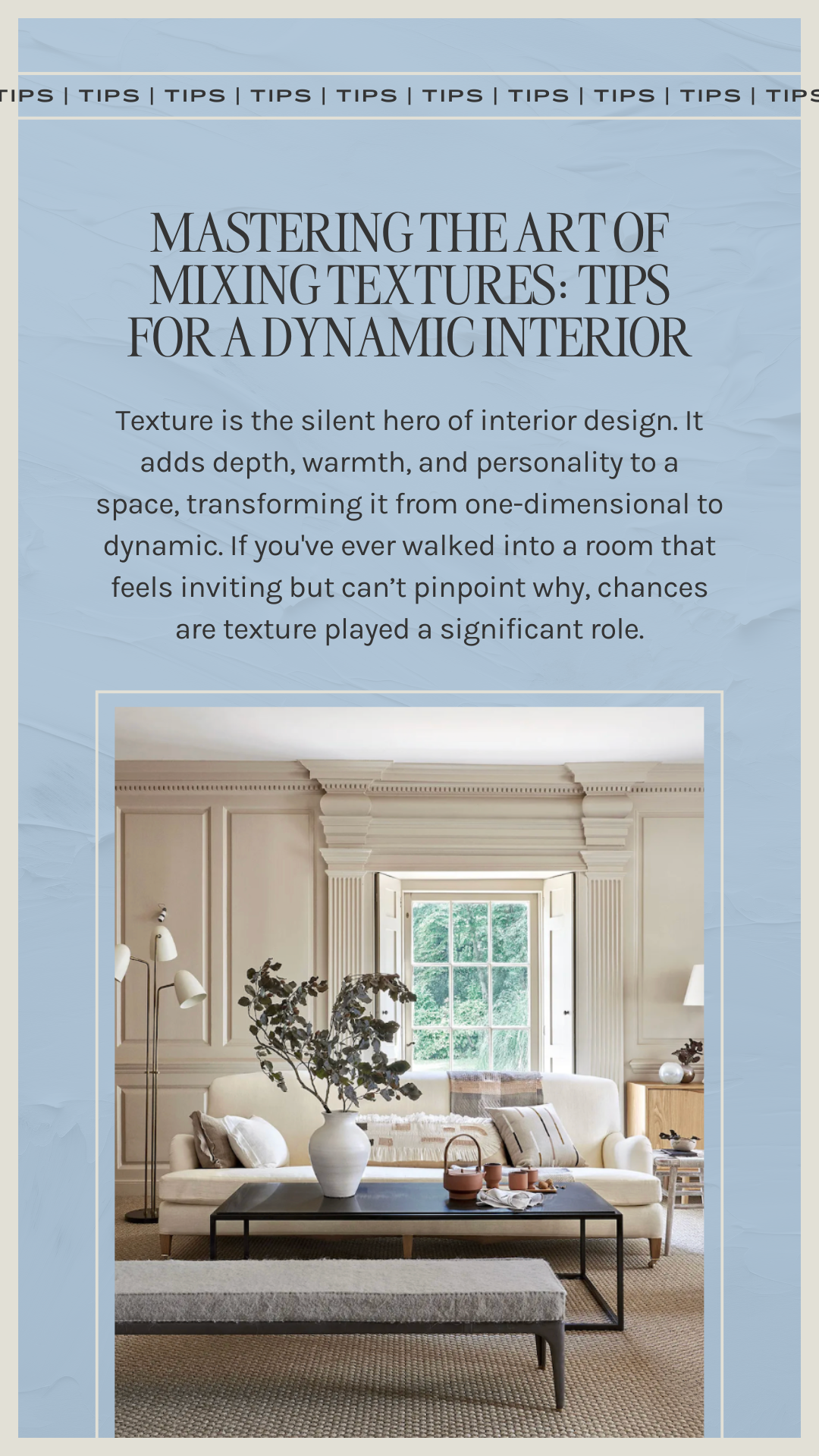Mastering the Art of Mixing Textures: Tips for a Dynamic Interior
Texture is the silent hero of interior design. It adds depth, warmth, and personality to a space, transforming it from one-dimensional to dynamic. If you've ever walked into a room that feels inviting but can’t pinpoint why, chances are texture played a significant role. Let’s explore how to master the art of mixing textures to create interiors that feel rich, layered, and alive.
5 Tips for Mixing Textures Like a Pro
1. Start with a Balanced Base
Begin by establishing a balanced base in your room. Neutral walls, furniture, or flooring in simple textures create a blank canvas for layering more dynamic materials. A subtle backdrop allows you to play with contrasting textures, like woven rugs or plush throws, without overwhelming the space. A balanced base sets the tone and creates a foundation that grounds bolder texture choices.
2. Layer Contrasting Textures
A well-designed room has a mix of textures that create contrast and interest. Pairing soft, smooth textures like velvet or silk with rougher materials like natural wood or stone brings a tactile richness to the room. For example, placing a woven jute rug under a sleek metal coffee table adds depth and dimension, creating a visually pleasing contrast that draws the eye. Think of mixing textures as an opportunity to play with opposites—hard vs. soft, shiny vs. matte, refined vs. rustic.
3. Use Nature as Inspiration
One of the hallmarks of a thoughtfully designed space is the use of organic materials that connect the indoors with nature. Natural textures like wood, leather, rattan, and linen add warmth and character, creating a grounded, earthy feel. Wood furniture, for instance, pairs beautifully with soft linen upholstery or a chunky wool throw, creating a balanced, natural vibe that feels welcoming and timeless.
4. Use Textiles for Comfort and Style
Textiles are a key way to layer textures without taking up too much visual space. Use items like throw pillows, blankets, and curtains in varying textures to add comfort and style. Consider mixing smooth silk or velvet pillows with chunky knits and woven fabrics to add richness and dimension to a seating area or bedroom. Textile layering is a simple, versatile way to experiment with texture while maintaining flexibility in your design.
5. Don’t Forget Metal and Glass
Metal and glass are often overlooked when thinking about texture, but they play a crucial role in adding balance and sophistication to a space. Incorporate elements like brass, copper, or brushed steel accents, along with glass tabletops or decor, to add a touch of sleekness and shine. These materials complement softer textures, creating a refined, modern contrast that elevates the room’s overall aesthetic.
6. Embrace Patterns as Texture
Patterns can act as a form of visual texture, adding depth without adding physical bulk. Subtle patterns on throw pillows, rugs, or wallpaper bring a layered look that adds movement and interest to the room. Floral patterns, geometric designs, or organic prints can complement the natural textures and break up solid colors, bringing an extra layer of complexity to your space.
7. Experiment with Scale and Proportion
When mixing textures, it’s essential to consider the scale and proportion of each item. Larger, bolder textures, like a chunky knit blanket or a reclaimed wood coffee table, serve as statement pieces, while smaller, finer textures—like a woven basket or a smooth ceramic vase—offer subtle contrast. Balancing large and small textures keeps the room feeling dynamic without overwhelming the senses.
8. Add Texture to Walls and Ceilings
Textured walls and ceilings are a powerful way to add character to a room. Consider options like textured wallpaper, shiplap, or exposed brick for an architectural element that draws the eye. Even a painted accent wall can add subtle depth to the space. If you’re looking to create a sophisticated statement, try incorporating a textured ceiling fixture, like a wooden or beaded chandelier, to add warmth and focus overhead.
9. Play with Light and Shadow
Lighting can bring out the richness of textures in a room, highlighting subtle details and creating depth through shadow. Use a combination of ambient, task, and accent lighting to emphasize the layered textures in your design. Floor lamps, pendant lights, and sconces in different finishes not only illuminate but also enhance the visual contrast between textures, adding a polished, intentional feel to the room.
10. Personalize with Finishing Touches
Finally, infuse your personality into the space by adding textured decor that resonates with you. A sculptural vase, a woven basket, or handmade pottery can be unique additions that complete the look. Personal items with texture add authenticity and warmth, making the room feel truly yours. These finishing touches help reinforce the thoughtful layering of textures, resulting in a space that feels balanced, inviting, and reflective of your style.
Final Thoughts
Mixing textures is all about storytelling. It’s a way to make a space feel personal, layered, and lived-in. Don’t be afraid to experiment! Start small—perhaps by adding a textured throw to your sofa or swapping out smooth curtains for something with more dimension. Over time, you’ll discover your own rhythm for creating textural harmony in your home.
Remember: The magic of texture lies in how it makes you feel. Whether it’s the cozy embrace of a knit blanket or the cool touch of a marble countertop, texture brings soul to design







